Labradorite is a captivating gemstone renowned for its stunning play-of-color, making it highly valued in the world of jewelry and ornamental crafts. Its unique iridescence, known as labradorescence, sets it apart from other stones, casting a mesmerizing display of colors when viewed from different angles. Beyond its aesthetic appeal, Labradorite holds significance in various cultural, spiritual, and metaphysical realms, adding layers of depth to its allure.
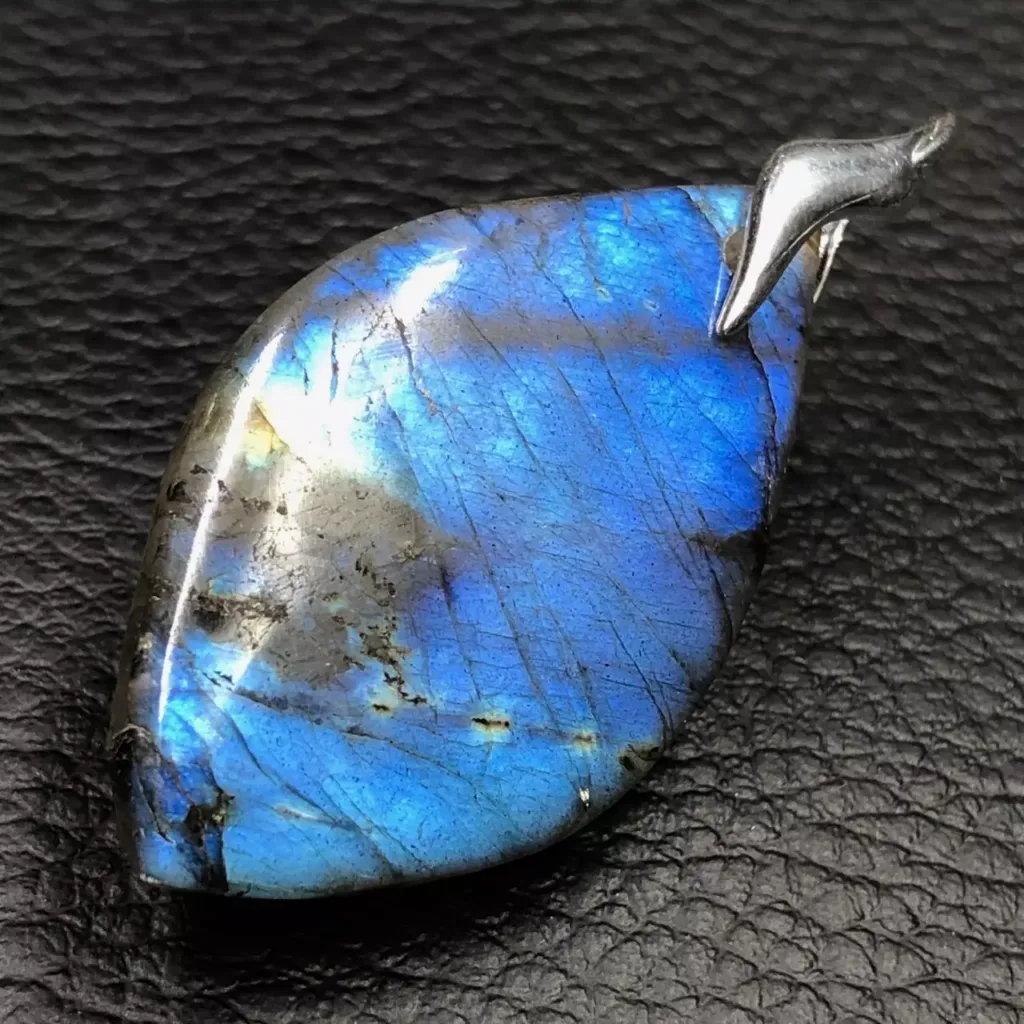
Definition and Brief Overview of Labradorite
Labradorite belongs to the feldspar mineral group and is characterized by its distinct optical phenomenon called labradorescence. This phenomenon arises from the scattering of light by microscopic structures within the stone, causing spectral colors to flash across its surface when illuminated. Labradorite typically exhibits a base color ranging from gray to black, with flashes of vibrant hues such as blue, green, yellow, and orange dancing across its surface.
This gemstone was first discovered in Labrador, Canada, in the late 18th century, hence its name. However, Labradorite can also be found in various other regions worldwide, including Madagascar, Finland, Australia, and Russia. It is commonly used in jewelry making, sculpture, and decorative objects due to its striking appearance and durability.
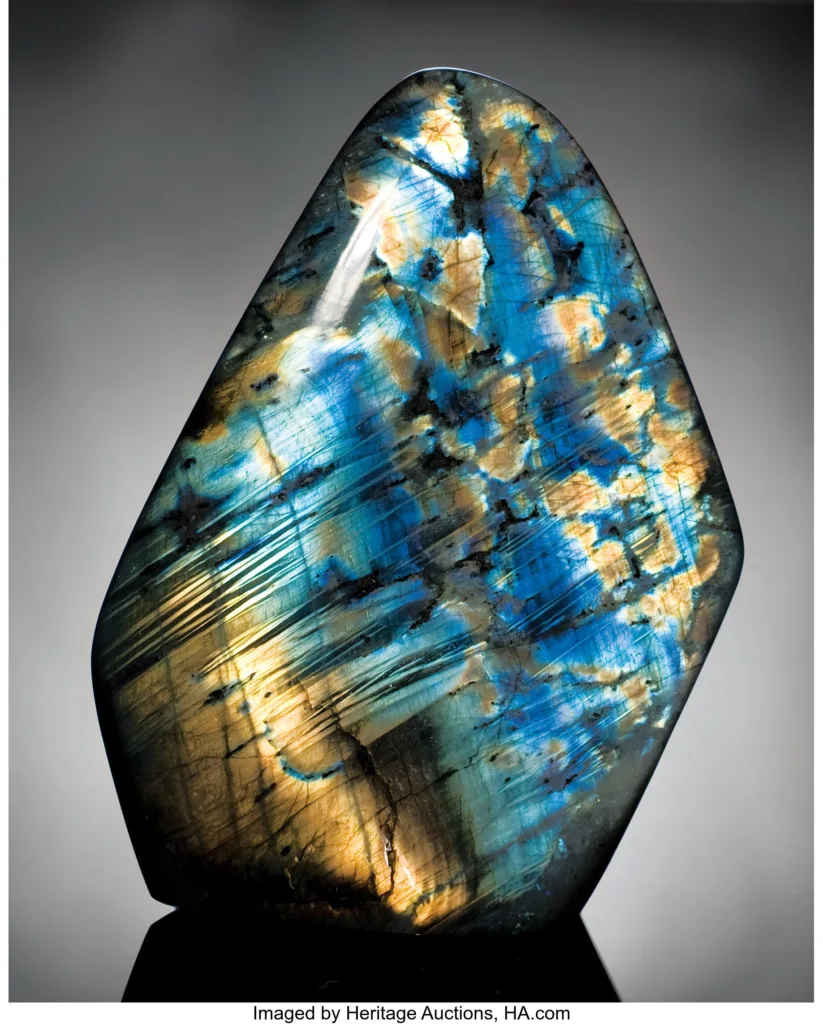
Importance and Relevance of Labradorite
Labradorite holds significant cultural, spiritual, and metaphysical importance across different societies and belief systems.
- Cultural Significance: In indigenous cultures, Labradorite is often regarded as a stone of transformation and protection. It is believed to possess mystical properties that aid in spiritual growth, healing, and enhancing psychic abilities. Labradorite has been used in ceremonial practices and as an amulet to ward off negative energies.
- Spiritual Relevance: In the realm of spirituality, Labradorite is associated with the third eye chakra, which is believed to govern intuition, insight, and spiritual vision. It is thought to facilitate a deeper connection with one’s inner self and higher consciousness, allowing for greater clarity and understanding.
- Metaphysical Properties: Labradorite is prized by crystal healers and practitioners of alternative medicine for its purported healing properties. It is said to balance and cleanse the aura, promote emotional well-being, and alleviate anxiety and stress. Some also believe that Labradorite can enhance creativity, intuition, and psychic abilities.
In addition to its spiritual and metaphysical attributes, Labradorite continues to captivate artists, designers, and collectors for its sheer beauty and versatility. Its iridescent play-of-color adds a touch of magic to any piece of jewelry or decorative item, making it a cherished addition to any collection.
Overall, Labradorite’s significance transcends mere aesthetics, intertwining with cultural traditions, spiritual beliefs, and holistic practices to enrich the lives of those who encounter it.
Geological Background
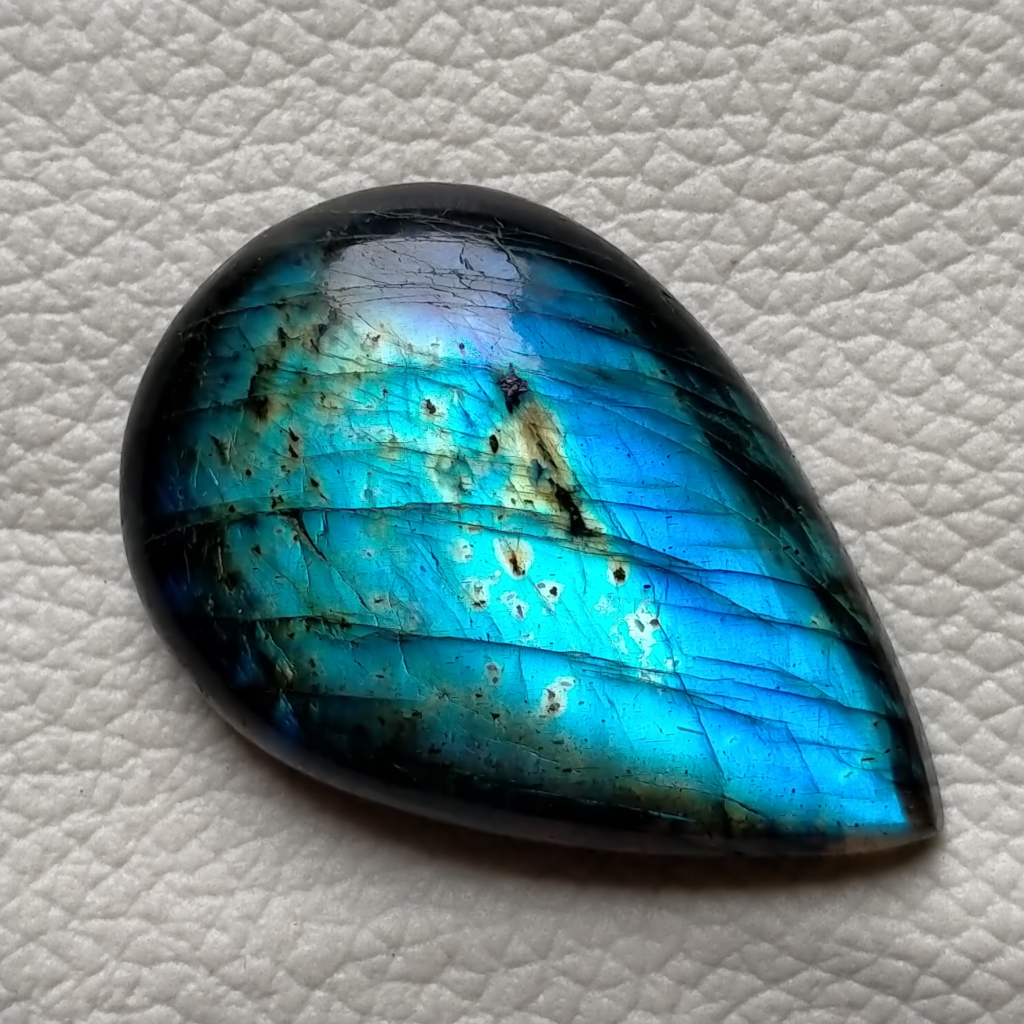
Labradorite is a mineral belonging to the feldspar group, which is one of the most abundant mineral groups in the Earth’s crust. It is a tectosilicate, meaning it has a three-dimensional framework structure, making up a significant portion of many igneous, metamorphic, and sedimentary rocks.
Formation Process
Labradorite forms primarily in igneous rocks through a process called crystallization. It typically crystallizes from magma that cools slowly underground, allowing for the growth of large, well-formed crystals. As the magma cools, minerals within it begin to crystallize out in a specific order based on their chemical composition and temperature. Labradorite forms when specific conditions favor the growth of feldspar crystals rich in calcium and sodium.
During crystallization, certain chemical elements may become incorporated into the crystal lattice, leading to the formation of the distinctive labradorescence observed in Labradorite. Microscopic lamellae within the crystal structure scatter light, creating the iridescent effect for which Labradorite is famous.

Geological Locations where Labradorite is Found
Labradorite was first discovered in Labrador, Canada, hence its name. However, it is also found in various other regions worldwide, particularly in areas with significant geological activity such as:
- Canada: Besides Labrador, Labradorite deposits can also be found in other parts of Canada, including Newfoundland and Quebec.
- Madagascar: Madagascar is another significant source of Labradorite, known for producing stones with exceptional color play and clarity.
- Finland: Labradorite is found in various locations in Finland, particularly in the regions of Ylämaa and Tuupovaara.
- Russia: Labradorite deposits exist in Russia, with notable occurrences in the Kola Peninsula and the Ural Mountains.
- Australia: Labradorite has been found in limited quantities in Australia, primarily in the state of New South Wales.
- United States: Labradorite can also be found in certain states in the U.S., including Oregon and Montana.
Associated Minerals and Geological Context
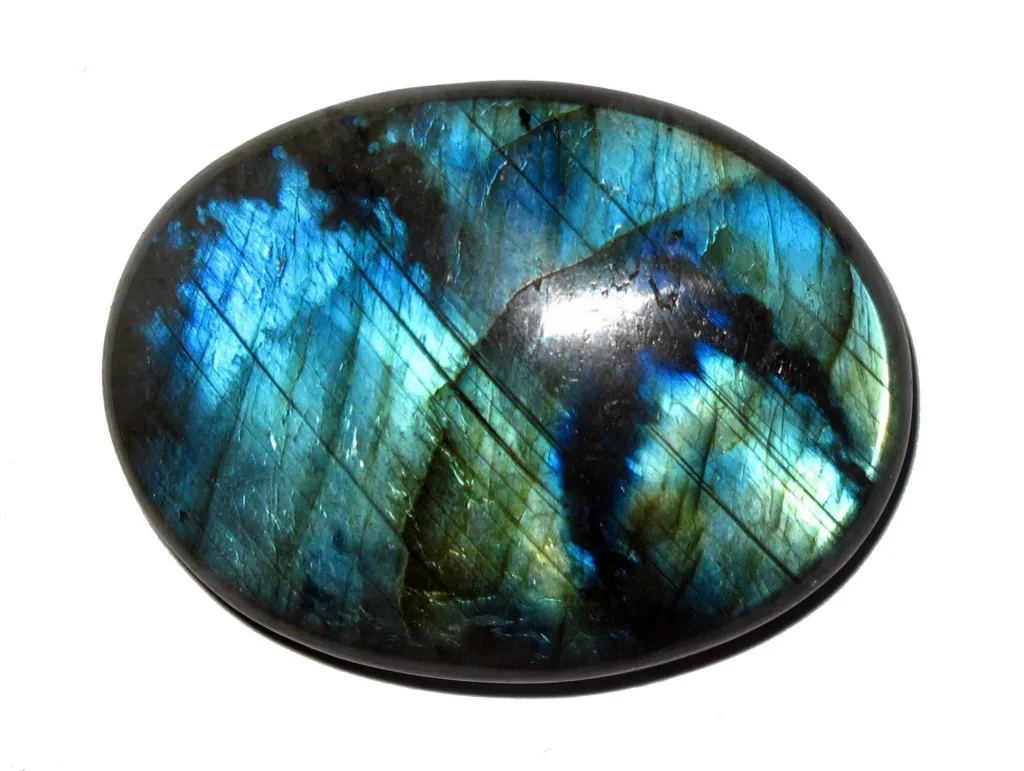
Labradorite is often found in association with other minerals, depending on the specific geological environment where it forms. Common associated minerals include:
- Other Feldspars: Labradorite may occur alongside other feldspar minerals such as orthoclase, microcline, and albite.
- Quartz: Quartz is frequently found in association with Labradorite, especially in igneous rocks where both minerals crystallize from magma.
- Mafic Minerals: Minerals rich in magnesium and iron, such as amphiboles (like hornblende) and pyroxenes (like augite), are commonly found alongside Labradorite in igneous rocks.
- Accessory Minerals: Labradorite may also contain accessory minerals such as magnetite, ilmenite, apatite, and zircon, which can contribute to its coloration and overall appearance.
Understanding the geological context of Labradorite deposits is crucial for both exploration and extraction purposes, as it helps geologists and miners identify potential sources and assess the economic viability of mining operations.
Physical Properties
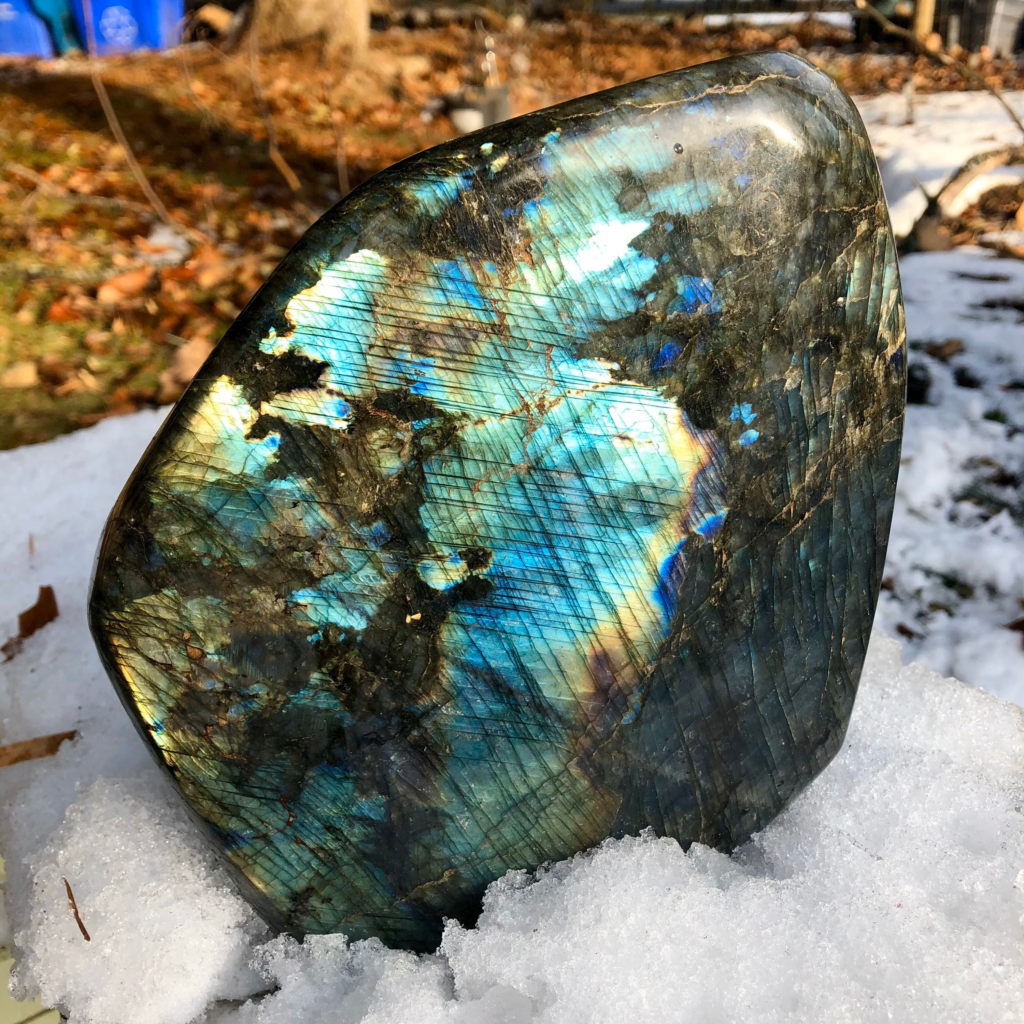
Labradorite exhibits a range of physical properties that contribute to its unique appearance and practical uses. Here are some of the key physical properties of Labradorite:
- Color: Labradorite typically displays a dark base color that can range from gray to black. However, its most distinctive feature is its iridescence, known as labradorescence, which manifests as vibrant flashes of colors such as blue, green, yellow, orange, and sometimes even purple or pink. The specific colors and intensity of labradorescence vary depending on the angle of observation and the quality of the stone.
- Luster: Labradorite has a vitreous to subvitreous luster, meaning it can appear glassy or slightly resinous when polished.
- Transparency: Labradorite is typically translucent to opaque, with higher-quality specimens often exhibiting greater transparency, especially in thinner sections.
- Crystal System: Labradorite crystallizes in the triclinic crystal system, characterized by three unequal crystal axes and angles that are not right angles.
- Hardness: Labradorite has a hardness of around 6 to 6.5 on the Mohs scale, making it moderately hard. While it can withstand normal wear and tear, Labradorite may still be susceptible to scratching and abrasion from harder materials.
- Cleavage: Labradorite exhibits two distinct cleavage directions that intersect at approximately 90 degrees. This cleavage is generally poor to distinct, meaning the mineral can break along these planes with varying degrees of ease.
- Fracture: The fracture of Labradorite is typically uneven to conchoidal, meaning it may produce irregular or curved surfaces when broken.
- Specific Gravity: The specific gravity of Labradorite ranges from approximately 2.68 to 2.72, indicating that it is slightly denser than water.
- Streak: The streak of Labradorite, the color left behind when the mineral is scraped across an unglazed porcelain plate, is typically white.
These physical properties contribute to Labradorite’s aesthetic appeal, durability, and suitability for various applications, including jewelry making, lapidary work, and ornamental uses. Additionally, understanding these properties is essential for identifying, evaluating, and working with Labradorite in both scientific and commercial contexts.
Chemical Composition
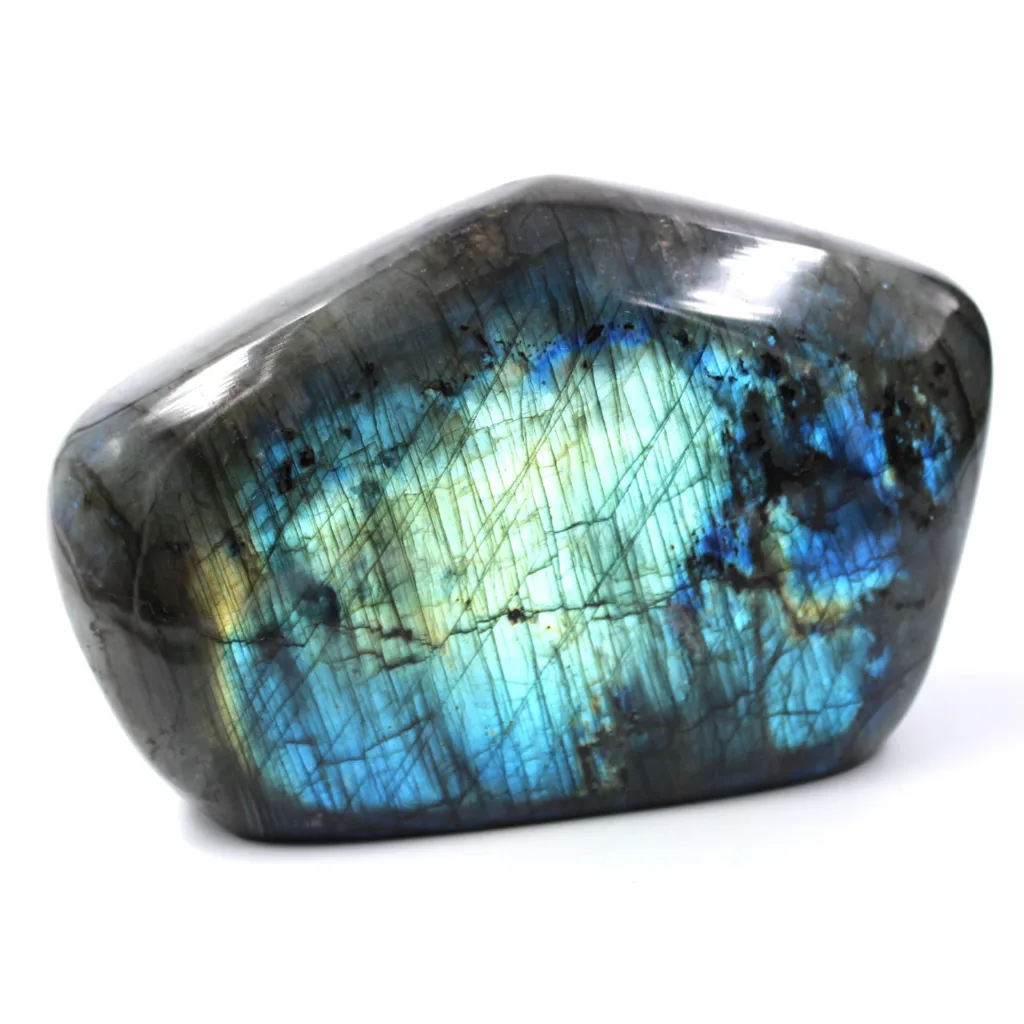
The chemical composition of Labradorite is primarily defined by its classification as a feldspar mineral, which places it within the framework silicate group. The general chemical formula for Labradorite can be represented as:
(Na,Ca)(Si,Al)4O8
This formula indicates that Labradorite contains varying proportions of sodium (Na), calcium (Ca), silicon (Si), and aluminum (Al) ions, along with oxygen (O) atoms. The specific composition may vary within the solid solution series of feldspar minerals, where Labradorite falls.
In addition to these primary elements, Labradorite may also contain trace amounts of other elements that can influence its color, clarity, and other properties. These elements may include potassium (K), iron (Fe), magnesium (Mg), titanium (Ti), and others.
The distinctive iridescence or labradorescence of Labradorite is attributed to the presence of minute lamellae or layers within the crystal structure. These layers consist of different compositions and orientations, which scatter light and produce the characteristic play of colors observed in Labradorite.
Overall, Labradorite’s chemical composition contributes to its unique optical properties, physical characteristics, and suitability for various geological, decorative, and lapidary applications.
Uses and Applications
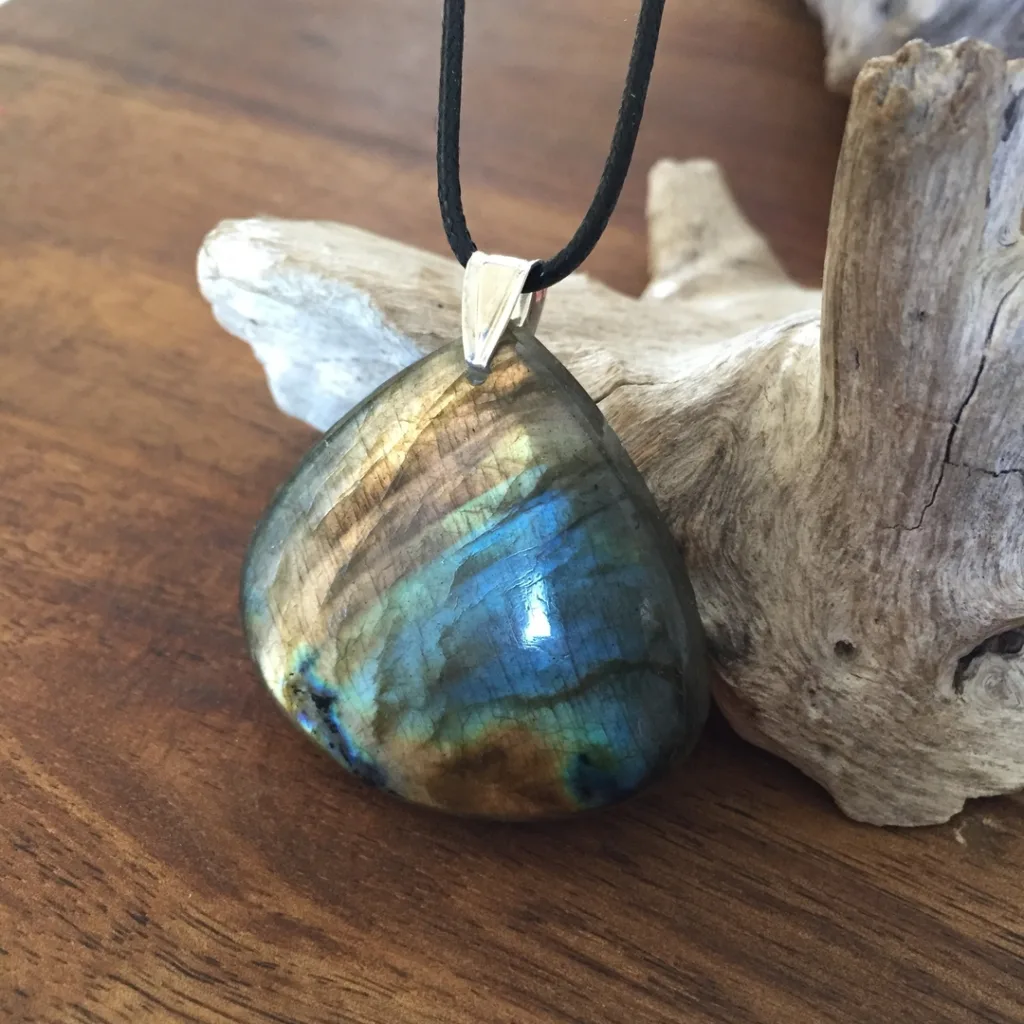
Labradorite’s captivating beauty and unique optical properties make it a versatile gemstone with a wide range of uses and applications. Some of the most common uses and applications of Labradorite include:
- Jewelry: Labradorite is highly valued in the jewelry industry for its iridescent play-of-color, which adds a touch of elegance and mystique to any piece. It is often used in various types of jewelry, including rings, earrings, pendants, bracelets, and necklaces. Labradorite cabochons, faceted stones, and beads are popular choices for jewelry designers seeking to incorporate its mesmerizing colors into their creations.
- Ornamental Objects: Labradorite’s striking appearance also makes it a popular choice for ornamental objects and decorative items. It is commonly used in sculptures, carvings, and figurines, where its iridescence can enhance the visual appeal and artistic value of the piece.
- Lapidary Work: Labradorite is frequently used by lapidaries and stonecutters to create polished gemstones, cabochons, beads, and other lapidary products. Its moderate hardness and attractive color play make it well-suited for cutting, shaping, and polishing into various forms for use in jewelry and decorative arts.
- Metaphysical and Spiritual Practices: Labradorite holds significance in metaphysical and spiritual traditions, where it is believed to possess healing properties and metaphysical energies. It is often used as a meditation stone, talisman, or amulet to promote spiritual growth, intuition, and psychic abilities. Labradorite may also be incorporated into rituals, ceremonies, and energy healing practices for its purported ability to balance and cleanse the aura.
- Collecting and Display: Labradorite’s unique beauty and rarity make it a sought-after collectible for gem and mineral enthusiasts. Collectors may acquire specimens of Labradorite for display purposes, either in their natural form or as polished specimens showcasing its iridescence and crystal structure.
- Architectural and Interior Design: Labradorite can be used as a decorative stone in architectural projects, interior design, and landscaping applications. Its iridescent colors and durability make it suitable for countertops, wall cladding, flooring, and other architectural features, adding a touch of luxury and sophistication to residential and commercial spaces.
- Gifts and Souvenirs: Labradorite jewelry, carvings, and other items make unique and memorable gifts for special occasions such as birthdays, anniversaries, and holidays. Additionally, Labradorite souvenirs from regions known for their deposits, such as Labrador in Canada or Madagascar, can serve as meaningful reminders of travels and experiences.
Overall, Labradorite’s versatility, beauty, and metaphysical associations contribute to its widespread popularity and diverse range of uses in jewelry, art, spirituality, and design.
Historical Significance

Labradorite holds historical significance across various cultures and civilizations, often intertwined with folklore, mythologies, and spiritual beliefs. Here are some aspects of its historical significance:
- Indigenous Cultures: Labradorite is revered by indigenous cultures, particularly those native to the regions where it is found. In Labrador, Canada, where the stone was first discovered, indigenous peoples have long revered Labradorite for its mystical properties and believed it to be imbued with the spirits of the Northern Lights. Labradorite was often used in spiritual ceremonies and rituals, serving as a protective talisman and a symbol of transformation.
- Inuit Legends: In Inuit mythology, Labradorite is said to have fallen from the Aurora Borealis (Northern Lights) and was once considered a stone of magic. According to legend, the Northern Lights were trapped within the rocks along the coast of Labrador, hence the name Labradorite. Inuit shamans and spiritual leaders believed Labradorite could facilitate communication with the spirit world and provide protection during journeys.
- Eskimo Carvings: Labradorite has been used by indigenous peoples, including the Inuit and Eskimo tribes, to create intricate carvings and sculptures. These carvings often depict animals, mythical creatures, and spiritual symbols, reflecting the cultural significance and reverence for the stone.
- Ancient Civilizations: Labradorite has been found in archaeological excavations of ancient civilizations, indicating its use and significance throughout history. While the exact beliefs and practices surrounding Labradorite in these cultures may not be fully known, its presence suggests that it held some form of value or symbolism.
- European Exploration and Trade: Labradorite gained recognition in the Western world during the late 18th and early 19th centuries when European explorers and traders began to bring specimens back from Labrador, Canada. Its iridescent beauty fascinated collectors and gem enthusiasts, leading to increased demand and trade in Labradorite specimens.
- Modern Spiritual Practices: Labradorite continues to be revered in modern spiritual practices, where it is believed to possess metaphysical properties that aid in spiritual growth, intuition, and protection. It is often used in crystal healing, meditation, and energy work, with practitioners attributing various healing and balancing effects to the stone.
Overall, Labradorite’s historical significance is deeply rooted in the cultural beliefs, mythologies, and spiritual traditions of indigenous peoples and ancient civilizations. Its mystical allure and captivating beauty have captivated humanity for centuries, leaving an indelible mark on the collective consciousness of those who encounter it.
Economic Value

Labradorite holds significant economic value in various industries due to its unique optical properties, durability, and aesthetic appeal. Here are some factors contributing to its economic value:
- Jewelry Industry: Labradorite is highly sought after in the jewelry industry for its iridescent play-of-color, which adds a touch of elegance and mystique to jewelry pieces. Jewelry items featuring Labradorite, such as rings, earrings, pendants, and bracelets, often command premium prices due to the stone’s rarity and beauty. Jewelry designers and manufacturers utilize Labradorite in both fine jewelry and fashion jewelry, catering to a wide range of consumers.
- Lapidary and Gemstone Trade: Labradorite is a popular choice among lapidaries and gemstone cutters for creating polished gemstones, cabochons, beads, and other lapidary products. The stone’s moderate hardness and attractive color play make it suitable for cutting, shaping, and polishing into various forms for use in jewelry and decorative arts. Labradorite specimens with exceptional color play and clarity can fetch higher prices in the gemstone trade.
- Ornamental and Decorative Uses: Labradorite’s striking appearance and iridescent colors make it a favored choice for ornamental objects and decorative items. Sculptors, artisans, and craftsmen use Labradorite to create sculptures, carvings, figurines, and decorative objects, adding a touch of luxury and sophistication to interior spaces. Labradorite’s economic value in the ornamental market is driven by its aesthetic appeal and the demand for unique, visually striking décor pieces.
- Metaphysical and Spiritual Products: Labradorite’s metaphysical properties and spiritual associations have led to its use in various metaphysical and spiritual products, including meditation stones, talismans, and crystal healing tools. Businesses catering to the metaphysical market often offer Labradorite products alongside other gemstones and crystals, capitalizing on the stone’s perceived healing and energetic properties.
- Tourism and Souvenir Industry: Regions known for their Labradorite deposits, such as Labrador in Canada and Madagascar, often capitalize on the stone’s popularity by incorporating it into local tourism and souvenir industries. Visitors to these regions may purchase Labradorite jewelry, carvings, and other items as souvenirs of their travels, contributing to the local economy through tourism-related spending.
- Export and International Trade: Labradorite-producing countries export the stone to international markets, where it is traded among gemstone dealers, wholesalers, and retailers. The global demand for Labradorite drives its export value and contributes to the economies of exporting countries. Labradorite’s economic significance in international trade is influenced by factors such as supply and demand dynamics, market trends, and consumer preferences.
Overall, Labradorite’s economic value stems from its desirability in various industries, including jewelry, lapidary, décor, metaphysical, and tourism. As a result, Labradorite plays a significant role in local economies and international trade, contributing to employment, income generation, and economic growth in regions where it is mined and processed.
Summary of key points

- Definition and Overview: Labradorite is a feldspar mineral known for its iridescent play-of-color, called labradorescence, which creates vibrant flashes of color across its surface.
- Formation: Labradorite forms primarily in igneous rocks through the crystallization of magma deep within the Earth’s crust. Its unique optical properties are a result of the scattering of light by microscopic structures within the crystal lattice.
- Geological Locations: Labradorite is found in various regions worldwide, including Canada (Labrador), Madagascar, Finland, Russia, Australia, and the United States.
- Associated Minerals: Labradorite is often found alongside other minerals such as other feldspars, quartz, mafic minerals (e.g., amphiboles, pyroxenes), and accessory minerals (e.g., magnetite, ilmenite, apatite).
- Physical Properties: Labradorite exhibits a dark base color ranging from gray to black, with flashes of vibrant hues like blue, green, and yellow. It has a vitreous to subvitreous luster, a hardness of 6 to 6.5 on the Mohs scale, and a triclinic crystal system.
- Chemical Composition: Labradorite’s chemical composition includes sodium (Na), calcium (Ca), silicon (Si), aluminum (Al), and oxygen (O), with trace elements contributing to its color and optical properties.
- Uses and Applications: Labradorite is utilized in various industries, including jewelry making, lapidary work, ornamental objects, metaphysical practices, architectural design, and souvenir items.
- Historical Significance: Labradorite has cultural and mythological significance in indigenous cultures, particularly in regions where it is found. It has been revered for its mystical properties and connection to the Northern Lights.
- Economic Value: Labradorite holds economic value in industries such as jewelry, lapidary, décor, metaphysical products, tourism, and international trade, contributing to local economies and global markets.
These key points encapsulate the geological, physical, cultural, and economic aspects of Labradorite, highlighting its significance and versatility in various contexts.




































